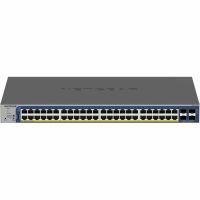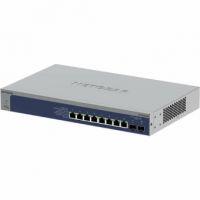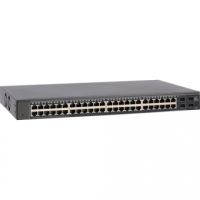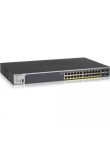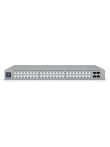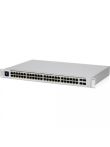Smart Switches
- Netgear GS752TXUP-300NAS 48-Port Gigabit PoE++ Smart Switch
 In Stock
In StockBrand: Netgear SKU: GS752TXUP-300NAS Condition: NEW USD 1088.81 - Netgear XS508TM-100NAS Smart S3600 XS508TM Ethernet Switch
 In Stock
In StockBrand: Netgear SKU: XS508TM-100NAS Condition: NEW USD 812.78 - Netgear GS728TX-300NAS 24P GE SMART SWTH W 10G SFP
 In Stock
In StockBrand: Netgear SKU: GS728TX-300NAS Condition: NEW USD 359.57 - Netgear GS748Tv5 ProSAFE Gigabit Smart Switch
 Out of Stock
Out of StockBrand: Netgear SKU: GS748T-500NAS Condition: NEW Call us for price(669) 244-0333
- Netgear GS752TX-300NAS 48P GE SMART SWTH W 10G SFP
 Out of Stock
Out of StockBrand: Netgear SKU: GS752TX-300NAS Condition: NEW Call us for price(669) 244-0333
How to Choose Smart Network Switches in 2025
In any network, the role of Ethernet switches is critical. They help IT devices, such as routers or access points, to communicate with each other by receiving and forwarding information as data packets. Therefore, the type and specifications of Ethernet switches determine the performance, control, and scalability of your network.
Network Switches are of various types, including managed switches, unmanaged switches, and smart switches. Each type offers a different set of functionalities, making it suitable for a particular set of network infrastructure. In this regard, understanding differences between these three types is crucial to deciding which network switch is best suited to your needs.
Here is a table showing the differences between these three types of network switches.
Managed Switch vs Unmanaged Switch Vs Smart Switch:
Here is a summarized version of the differences for your understanding.
|
Features |
Smart Switches |
||
|
Configuration Options |
None, essentially plug-and-play |
Full configuration and control (VLANs, QoS, SNMP, Layer 3 routing) |
Basic to intermediate configuration (VLANs, QoS, port management via web interface) and monitoring |
|
Management Level |
No management |
Fully managed, making them suitable for large and complex networks |
Intermediate management, suitable for small to medium businesses |
|
QoS (Quality of Service) |
No |
Yes (advanced, customizable) |
Yes, but basic |
|
Security |
No, or minimal |
Advanced, granular control and monitoring |
Moderate, VLANs, and limited port control |
|
Features |
None, basic connectivity only |
Advanced features: VLANs, QoS, SNMP, Layer 3 routing, security, monitoring |
Basic VLANs, QoS, limited security, and monitoring |
|
Redundancy & Failover |
No |
Yes (Spanning Tree, LACP, etc.) |
Limited |
|
Scalability & Flexibility |
Low |
High, supports stacking, modular options |
Moderate, may support stacking and more ports |
|
Use cases |
home networks, small offices, or temporary setups that require simple device connectivity, for instance, when you need to connect printers, IP cameras, or access points |
Large enterprises, complex networks |
Small to medium-sized business (SMB) networks, particularly at the access layer, require network admins to have moderate control, remote management, and reliability. |
|
Examples |
TP-Link TL-SG105 |
Cisco Catalyst series, Juniper, Extreme Networks |
TP-Link Omada, Netgear GS110TP |
Now that we have understood the main differences between these Ethernet switches, how can one choose a smart switch that is best-suited for his or her requirements?
Let’s look into these factors.
Factors to Look into a Top-Quality Smart Network Switch:
Here are some factors that you need to know before making an eventual decision.
-
Port Configuration and Speed:
Smart switches are designed specifically for SME businesses. In this regard, the first thing you should look into is the speed and number of ports. Here are our recommendations:
|
Use Cases |
Recommended port configuration |
Speed required |
Capacity |
|
Small Homes, Small Offices |
5–8 ports |
Gigabit (1 Gbps) |
PCs, printers, NAS, and a few smart devices. |
|
Gaming / Streaming Setup |
8–12 ports |
Gigabit or 2.5 Gbps |
consoles, PCs, streaming boxes, and low-latency connections. |
|
Small Business / Startup |
16–24 ports |
Gigabit, with a few 10 Gbps uplinks |
multiple workstations, VoIP phones, and shared storage. |
|
Enterprise / Data Center |
24–48+ ports |
10 Gbps or higher |
High throughput for servers, virtualization, and large-scale traffic |
|
Smart Home / IoT Network |
8–16 ports |
Gigabit |
smart TVs, cameras, sensors, and hubs reliably. |
-
Management Features:
You should look for a web-based interface for easy configuration of VLANs, QoS, port mirroring, and traffic monitoring. Similarly, the smart switch you are looking for must also possess essential network protocols like DHCP snooping, IGMP snooping, spanning tree protocol, and LACP.
Additionally, static routing or Layer 3 Lite features should also be therefore for carrying out network segmentation and traffic control. You should also look for Insight Cloud, CLI, Remote Management, and Local Management.
-
Power over Ethernet (PoE) Capability
PoE is another feature that you should look into. PoE enables switches to provide power and data through a single Cat cable. You can thus save both space and resources and reduce cable from your workspace.
Power Over Ethernet can be PoE, PoE+, or PoE++. You can choose it as per the given table.
|
Features |
PoE (IEEE 802.3af) or Type 1 |
PoE+ (IEEE 802.3at) or Type 2 |
PoE++ (IEEE 802.3bt) or Type 3/4 |
|
Max Power per Port |
15.4 W (12.95 W to device) |
30 W (25.5 W to device) |
Type 3: 60 W (51 W to device) Type 4: 100 W (71 W to device) |
|
Voltage Range |
44–57 V |
50–57 V |
50–57 V |
|
Power Delivery Method |
2 pairs of wires |
2 pairs of wires |
4 pairs of wires |
|
Cable Type |
Cat5 or better |
Cat5 or better |
Cat5e or better is recommended |
|
Typical Use Cases |
Basic IP phones, cameras, APs |
Advanced IP phones, PTZ cameras, and higher power APs |
High-power devices like multi-radio APs, building automation, TVs, and small PCs |
-
Security Features:
In addition to management features, you need to focus on the robust security capabilities of the smart network switches as well. Here are some security features that you should look into.
-
VLAN-based security and port isolation for protecting sensitive network segments.
-
Access Control Lists (ACLs), 802.1X authentication, and potential integration with cybersecurity software for strengthening threat detection and prevention capabilities.
-
DHCP Snooping against the threats of IP spoofing and man-in-the-middle attacks.
-
Private VLANs ensure internal segmentation and prevent the lateral movement of threats.
-
MAC Address Filtering for adding an extra layer of device-level access control.
-
Secure Management Interfaces for ensuring encrypted administrative traffic and preventing eavesdropping
Having discussed the salient features of smart Ethernet switches, here are the top recommendations when it comes to the best smart switches in the USA.
Best Smart Network Switches You Should Look for in the USA:
Here are our top picks tailored to the specific networking needs of various user groups.
-
Best Smart Switch for Home Users:
TP-Link TL-SG105E is ranked as the best network switch for small home users. Featuring 5 ports and offering VLAN, QoS, IGMP Snooping, and monitoring, this TP-Link smart switch can provide you reliable network infrastructure for everyday home use.
Netgear GS308E is also a highly recommended smart Ethernet switch, suitable for home or home office needs. It comes with 8 ports with the same features for basic management and monitoring.
-
Best Smart Switch for Small Businesses:
TP-Link TL-SG116E is recommended as one of the best available options when it comes to a smart switch suitable for US-based businesses. It comes with 16 ports and VLAN, QoS, link aggregation, and some PoE options, allowing network administrators to enjoy affordable smart management for small offices.
Alternatively, you can choose the Netgear 8-Port Multi-Gigabit (2.5G) Ethernet Ultra60 PoE++ Smart Switch that can help you establish multi-gigabit networks for your small business needs.
-
Best Smart Switch for Small to Medium Business:
MikroTik CSS610-8G-2S+IN is a portable, powerful, and extremely cost-effective smart switch for your small business's needs. It comes with advanced features, including management and configuration of port-to-port forwarding, storm control, MAC filters, VLANs, mirror traffic bandwidth limitation, and MAC and IP header fields.
Alternatively, you can go for Netgear 24 Port Gigabit Ethernet PoE+ Smart Switch w/ optional Remote/Cloud Management and 2 SFP Ports (380W) that can help your SME business to establish a high-bandwidth network for mission-critical applications.
Final Thoughts:
Smart Ethernet switches are a sweet spot; they are better than unmanaged switches and provide some basic management and remote monitoring, which are not as advanced as what managed switches provide. Similar to other switch types, smart network switches should be chosen carefully. In this regard, port speed, port configuration, management capabilities, security features, and support for PoE should be given priority. We do hope that this write-up will help you make a well-informed decision when it comes to the best smart switch available in the USA.



